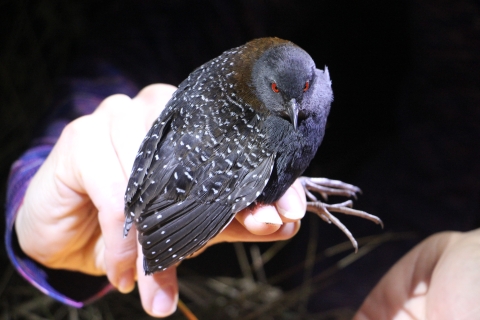Biologists surveying salt and freshwater marshes might hear the “kickee-doo” call of an eastern black rail more often now due to the work and research of Christy Hand, wildlife biologist with the South Carolina Department of Natural Resources. For her efforts, the U.S. Fish and Wildlife Service’s Southeast Region is recognizing her with a 2023 Recovery Champion Award.
Recovery Champion Awards are presented annually by the Service to its employees and partners who have made outstanding contributions toward the recovery of federally listed endangered and threatened species under the Endangered Species Act. The eastern black rail was listed as threatened on November 9, 2020. In the Southeast, the eastern black rail is found in Louisiana, and along the Atlantic Coast in North Carolina, South Carolina, Georgia, and Florida.
Christy Hand’s cutting-edge research, particularly concerning the breeding ecology and molting of eastern black rails, provided new knowledge about the bird. She also developed survey methods for this secretive and hard to find bird that are now considered standard. Christy used the findings from her research to develop effective methods of habitat creation, management, and restoration for the eastern black rail. She authored habitat management guidelines for the bird in South Carolina, and she has worked with public and private landowners to implement the guidelines.
“Any species would be lucky to have Christy Hand as an advocate in its corner,” says Morgan Wolf, fish and wildlife biologist with the U.S. Fish and Wildlife Service’s Ecological Services Recovery Planning Team. “She has a unique ability to build consensus and buy-in for the eastern black rail from a variety of stakeholders by exemplifying humility, capability, resilience, and kindness.”
Christy Hand heads several scientific groups working to recover the eastern black rail. She co-leads the Eastern Black Rail Autonomous Recording Unit and Bioacoustics Team and the Eastern Black Rail Executive Survey Design Team. She is the leader of the South Carolina Black Rails Group.
The eastern black rail is a sparrow-sized, gray-black bird with red eyes. Its underparts are speckled, and the nape of its neck is chestnut colored. It has a black bill and dusky pink or wine-colored legs. The bird’s diet includes beetles, spiders, snails, small crustaceans, grasshoppers, and ants. Eastern black rails walk or run through their marsh habitat, only come out at night, and rarely fly. The primary threats to the bird’s survival are habitat loss and degradation, erosion, environmental contaminants, sea level rise, and tidal flooding.






